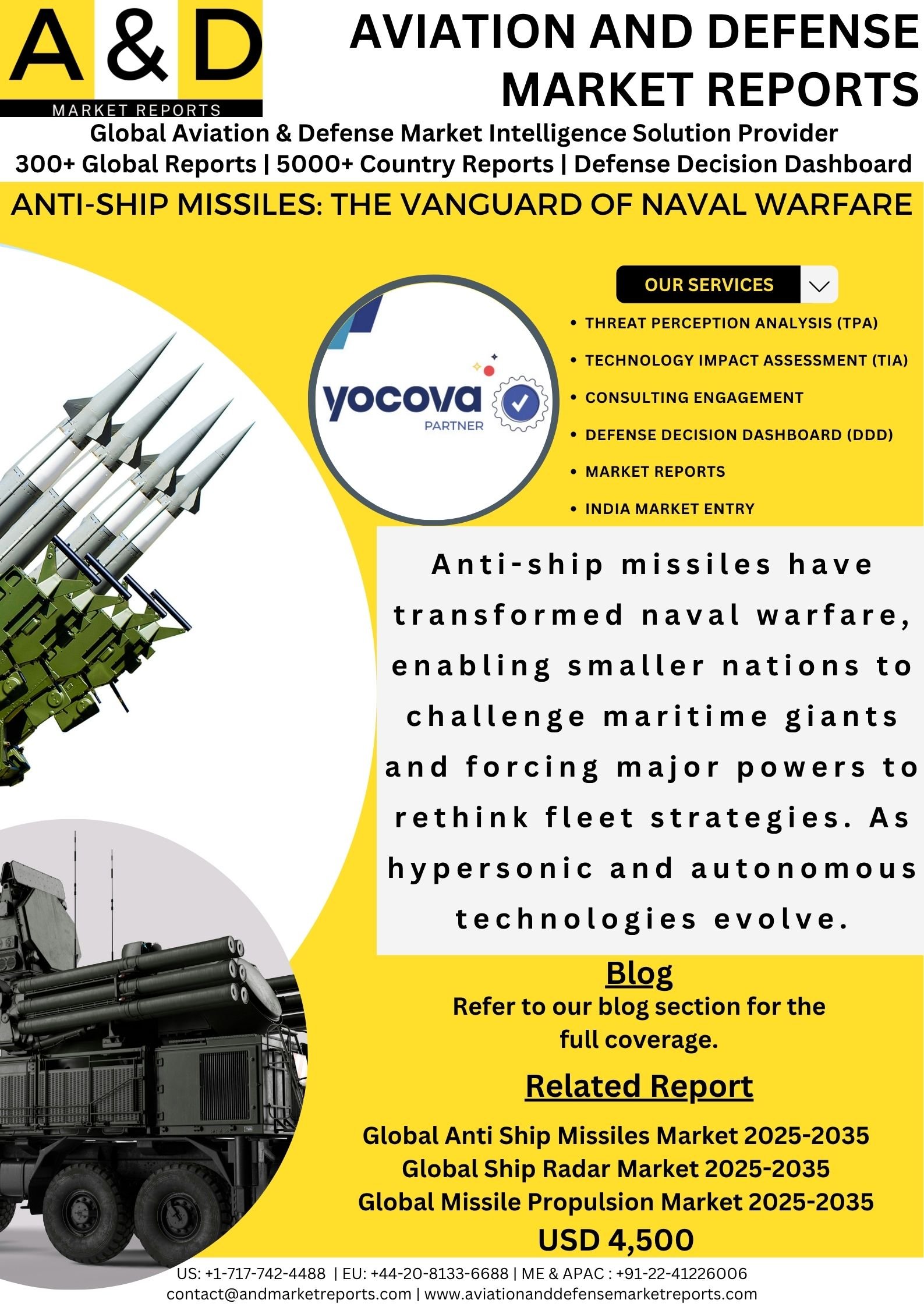Anti-ship missiles (ASMs) are precision-guided weapons designed to target and destroy naval vessels, reshaping modern naval warfare with their speed, accuracy, and destructive power. These missiles, deployed from platforms such as ships, submarines, aircraft, and coastal batteries, have become critical tools for nations seeking to project power, secure maritime borders, and counter adversary fleets. This blog explores the history, technology, types, strategic importance, and future trends of anti-ship missiles, with a focus on their role in India’s defence landscape and global naval strategies.
The Cold War saw rapid advancements, with the Soviet Union deploying missiles like the P-700 Granit and the United States introducing the Harpoon missile. By the 1980s, ASMs became integral to naval doctrines, with systems like France’s Exocet gaining prominence during the Falklands War (1982), where it sank the British destroyer HMS Sheffield. Today, advanced ASMs like China’s YJ-18 and Russia’s Zircon hypersonic missile define the cutting edge of naval warfare.
Technology Behind Anti-Ship Missiles
Anti-ship missiles are engineering marvels, integrating advanced propulsion, guidance, and warhead technologies. Key components include:
- Propulsion: Most ASMs use turbojet or turbofan engines for subsonic missiles (e.g., Harpoon, Exocet) and ramjet or scramjet engines for supersonic and hypersonic missiles (e.g., BrahMos, Zircon). Liquid or solid-fuel rocket boosters are common for initial launch.
- Guidance Systems: Modern ASMs employ inertial navigation, GPS, and active/passive radar for mid-course guidance, with terminal guidance using radar, infrared, or electro-optical seekers for precision targeting. Anti-jamming capabilities and low-observable (stealth) designs enhance survivability.
- Warheads: ASMs carry high-explosive warheads (100–500 kg), often with armor-piercing or blast-fragmentation capabilities. Some, like the Chinese DF-21D, are designed to disable aircraft carriers with kinetic energy or specialized warheads.
- Flight Profiles: ASMs use sea-skimming (low-altitude) or high-altitude dive trajectories to evade radar and air defenses. Hypersonic missiles, traveling above Mach 5, combine speed with unpredictable maneuvers.
Types of Anti-Ship Missiles
ASMs vary by range, speed, and launch platform, categorized as follows:
- Subsonic ASMs: Examples include the U.S. Harpoon (range: ~125 km, speed: ~0.85 Mach) and France’s Exocet (range: ~180 km). These are cost-effective, widely deployed, and suitable for smaller vessels but are vulnerable to modern air defenses.
- Supersonic ASMs: India’s BrahMos (range: ~600 km, speed: Mach 2.8–3) and Russia’s P-800 Oniks (range: ~800 km) offer higher speeds, reducing reaction time for targets. Their kinetic energy enhances destructive power.
- Hypersonic ASMs: Emerging systems like Russia’s Zircon (range: ~1,000 km, speed: Mach 8–9) and China’s YJ-21 use hypersonic speeds to overwhelm defenses, though they are complex and costly.
- Ballistic Anti-Ship Missiles: China’s DF-21D and DF-26, dubbed “carrier killers,” use ballistic trajectories and maneuverable re-entry vehicles to target large naval assets like aircraft carriers.
Launch platforms include surface ships, submarines (e.g., torpedo-tube-launched Harpoons), aircraft (e.g., BrahMos-A on Su-30 MKI), and coastal batteries (e.g., India’s coastal BrahMos batteries).
Strategic Importance of Anti-Ship Missiles
ASMs are pivotal in modern naval strategies, offering both offensive and defensive capabilities:
- Area Denial and A2/AD: Missiles like China’s DF-21D and India’s BrahMos enable Anti-Access/Area Denial (A2/AD) strategies, deterring adversaries from operating in contested waters like the South China Sea or Indian Ocean Region (IOR).
- Asymmetric Warfare: Smaller nations use ASMs to counter larger navies. For example, Iran’s arsenal of fast attack craft armed with ASMs poses a threat to U.S. naval assets in the Persian Gulf.
- Power Projection: Long-range ASMs allow nations to project force far from their shores, as seen with Russia’s deployment of Kalibr missiles in the Mediterranean.
- Carrier Strike Capability: Ballistic and hypersonic ASMs threaten aircraft carriers, traditionally the backbone of naval dominance, forcing navies to invest in advanced missile defense systems like Aegis or THAAD.
Global Players and Emerging Trends
Beyond India, major powers are advancing ASM technologies:
- United States: The Harpoon and Long-Range Anti-Ship Missile (LRASM) (range: ~500 km, stealth-enabled) are mainstays, with LRASM designed to penetrate advanced air defenses.
- China: The YJ-12, YJ-18, and DF-21D/DF-26 ballistic missiles form a robust A2/AD capability, challenging U.S. naval dominance in the Pacific.
- Russia: The Zircon hypersonic missile and Kalibr cruise missile enhance Russia’s ability to strike naval targets at long ranges.
- Europe: France’s Exocet and Norway’s Naval Strike Missile (NSM) are widely exported, offering reliable subsonic options.
Emerging trends include:
- Hypersonic Technology: Hypersonic ASMs, with speeds exceeding Mach 5, are harder to intercept due to their speed and maneuverability.
- Stealth and Autonomy: Future ASMs incorporate low-observable designs and AI-driven autonomous targeting to counter electronic countermeasures.
- Network-Centric Warfare: ASMs are increasingly integrated with satellite, drone, and radar networks for real-time targeting.
- Multi-Platform Versatility: Missiles like BrahMos and LRASM are adaptable across air, sea, and land platforms, enhancing operational flexibility.
Challenges and Countermeasures
Despite their advantages, ASMs face challenges:
- Cost: Hypersonic and advanced ASMs are expensive, limiting their adoption by smaller navies.
- Countermeasures: Modern naval vessels use electronic warfare systems, decoys, and missile defense systems (e.g., Aegis, Barak-8) to neutralize ASMs.
- Saturation Attacks: Navies counter ASMs with layered defenses, requiring attackers to launch salvos of missiles to overwhelm systems.
Navies are investing in laser-based defenses, like the U.S. Navy’s HELIOS system, and advanced radar to counter hypersonic threats.
Conclusion
Anti-ship missiles have transformed naval warfare, enabling smaller nations to challenge maritime giants and forcing major powers to rethink fleet strategies. As hypersonic and autonomous technologies evolve, ASMs will continue to shape the balance of power at sea, underscoring the need for robust countermeasures and strategic innovation
